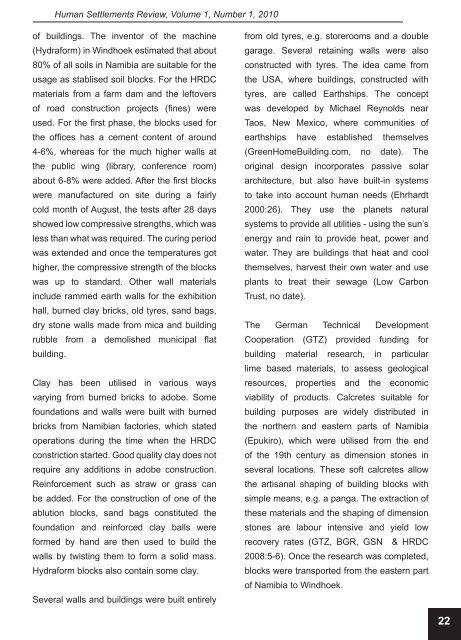Human Settlements Review - Parliamentary Monitoring Group
Human Settlements Review - Parliamentary Monitoring Group
Human Settlements Review - Parliamentary Monitoring Group
You also want an ePaper? Increase the reach of your titles
YUMPU automatically turns print PDFs into web optimized ePapers that Google loves.
<strong>Human</strong> <strong>Settlements</strong> <strong>Review</strong>, Volume 1, Number 1, 2010<br />
of buildings. The inventor of the machine<br />
(Hydraform) in Windhoek estimated that about<br />
80% of all soils in Namibia are suitable for the<br />
usage as stablised soil blocks. For the HRDC<br />
materials from a farm dam and the leftovers<br />
of road construction projects (fines) were<br />
used. For the first phase, the blocks used for<br />
the offices has a cement content of around<br />
4-6%, whereas for the much higher walls at<br />
the public wing (library, conference room)<br />
about 6-8% were added. After the first blocks<br />
were manufactured on site during a fairly<br />
cold month of August, the tests after 28 days<br />
showed low compressive strengths, which was<br />
less than what was required. The curing period<br />
was extended and once the temperatures got<br />
higher, the compressive strength of the blocks<br />
was up to standard. Other wall materials<br />
include rammed earth walls for the exhibition<br />
hall, burned clay bricks, old tyres, sand bags,<br />
dry stone walls made from mica and building<br />
rubble from a demolished municipal flat<br />
building.<br />
Clay has been utilised in various ways<br />
varying from burned bricks to adobe. Some<br />
foundations and walls were built with burned<br />
bricks from Namibian factories, which stated<br />
operations during the time when the HRDC<br />
constriction started. Good quality clay does not<br />
require any additions in adobe construction.<br />
Reinforcement such as straw or grass can<br />
be added. For the construction of one of the<br />
ablution blocks, sand bags constituted the<br />
foundation and reinforced clay balls were<br />
formed by hand are then used to build the<br />
walls by twisting them to form a solid mass.<br />
Hydraform blocks also contain some clay.<br />
Several walls and buildings were built entirely<br />
from old tyres, e.g. storerooms and a double<br />
garage. Several retaining walls were also<br />
constructed with tyres. The idea came from<br />
the USA, where buildings, constructed with<br />
tyres, are called Earthships. The concept<br />
was developed by Michael Reynolds near<br />
Taos, New Mexico, where communities of<br />
earthships have established themselves<br />
(GreenHomeBuilding.com, no date). The<br />
original design incorporates passive solar<br />
architecture, but also have built-in systems<br />
to take into account human needs (Ehrhardt<br />
2000:26). They use the planets natural<br />
systems to provide all utilities - using the sun’s<br />
energy and rain to provide heat, power and<br />
water. They are buildings that heat and cool<br />
themselves, harvest their own water and use<br />
plants to treat their sewage (Low Carbon<br />
Trust, no date).<br />
The German Technical Development<br />
Cooperation (GTZ) provided funding for<br />
building material research, in particular<br />
lime based materials, to assess geological<br />
resources, properties and the economic<br />
viability of products. Calcretes suitable for<br />
building purposes are widely distributed in<br />
the northern and eastern parts of Namibia<br />
(Epukiro), which were utilised from the end<br />
of the 19th century as dimension stones in<br />
several locations. These soft calcretes allow<br />
the artisanal shaping of building blocks with<br />
simple means, e.g. a panga. The extraction of<br />
these materials and the shaping of dimension<br />
stones are labour intensive and yield low<br />
recovery rates (GTZ, BGR, GSN & HRDC<br />
2008:5-6). Once the research was completed,<br />
blocks were transported from the eastern part<br />
of Namibia to Windhoek.<br />
22









![National Research Foundation Annual Report 2008 / 2009 [Part 2]](https://img.yumpu.com/49774036/1/177x260/national-research-foundation-annual-report-2008-2009-part-2.jpg?quality=85)







